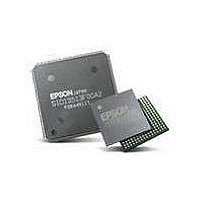S1D13743F00A200 Epson, S1D13743F00A200 Datasheet - Page 106

S1D13743F00A200
Manufacturer Part Number
S1D13743F00A200
Description
LCD Drivers LCD CNTRL w/Embedded 464KB SRAM
Manufacturer
Epson
Datasheet
1.S1D13743F00A200.pdf
(134 pages)
Specifications of S1D13743F00A200
Maximum Clock Frequency
33 MHz, 68.59 MHz
Operating Supply Voltage
1.5 V
Maximum Operating Temperature
+ 85 C
Package / Case
QFP-20-144
Attached Touch Screen
No
Maximum Supply Current
74 mA
Minimum Operating Temperature
- 40 C
Lead Free Status / RoHS Status
Lead free / RoHS Compliant
Available stocks
Company
Part Number
Manufacturer
Quantity
Price
Company:
Part Number:
S1D13743F00A200
Manufacturer:
EPSON
Quantity:
5 690
- Current page: 106 of 134
- Download datasheet (3Mb)
Page 106
S1D13743
X70A-A-001-02
Time 1:
The main/background image is
in Buffer 1. Buffer 2 is empty.
The data output to the LCD
comes entirely from Buffer 1.
Background
image
Buffer 1
Buffer 2
Output
It is also possible to update a static window while double buffering is enabled, even in the
middle of a video stream. To do this:
• Write the last pixel of the current frame of video data.
• Set the appropriate bits in the Special Effects Register, REG[36h] bits 7-6 to 01b.
• Setup the Window Position Registers, REG[38h] ~ REG[46h].
• Write the static data to the Memory Data Port, REG[48h] ~ REG[49h].
This allows a static image to be written at any time, while still preventing the double
buffered window from tearing. Once the static window has been written, the user can go
back to writing the streaming video data by following the steps described above for using
the double buffer feature.
Time 2:
The main/background image is
in Buffer 1. Buffer 2 is written
with video data. The data output
to the LCD comes entirely from
Buffer 1.
Input
Background
image
Buffer 2
Buffer 1
Figure 20-2: Double Buffer Example
Output
Revision 2.7
Input
Time 3:
The main/background image is
in Buffer 1, but part of this data is
destructively overwritten by the
second frame of video data. The
static image data from Buffer 1 is
sent to the LCD, but the video
window comes from Buffer 2.
Background
image
Buffer 1
Buffer 2
Output
Epson Research and Development
Hardware Functional Specification
Time 4:
A static PIP is destructively written
into Buffer 1. Since the most recently
updated video frame is in Buffer 1, the
entire image output to the LCD comes
from Buffer 1. There may be tearing in
the PIP window, but the video window
will not tear.
Input
Vancouver Design Center
Background
image
PIP
Buffer 2
Issue Date: 2010/05/18
Buffer 1
Output
Related parts for S1D13743F00A200
Image
Part Number
Description
Manufacturer
Datasheet
Request
R

Part Number:
Description:
Display Modules & Development Tools S1D13743 Eval board
Manufacturer:
Epson

Part Number:
Description:
INK CARTRIDGE, T0803, EPSON, MAG
Manufacturer:
Epson
Datasheet:

Part Number:
Description:
INK CARTRIDGE, T0804, EPSON, YEL
Manufacturer:
Epson
Datasheet:

Part Number:
Description:
CXA1034M
Manufacturer:
EPSON Electronics
Datasheet:

Part Number:
Description:
Manufacturer:
EPSON Electronics
Datasheet:

Part Number:
Description:
Manufacturer:
EPSON Electronics
Datasheet:

Part Number:
Description:
Manufacturer:
EPSON Electronics
Datasheet:

Part Number:
Description:
Manufacturer:
EPSON Electronics
Datasheet:

Part Number:
Description:
RTC58321Real time clock module(4-bit I/O CONNECTION REAL TIME CLOCK MODULE)
Manufacturer:
EPSON Electronics
Datasheet:

Part Number:
Description:
SCI7661DC-DC Converter
Manufacturer:
EPSON Electronics
Datasheet:

Part Number:
Description:
Manufacturer:
EPSON Electronics
Datasheet:

Part Number:
Description:
Manufacturer:
EPSON Electronics
Datasheet:











